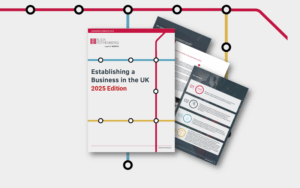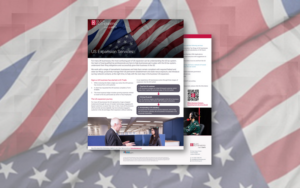Twelve tax tips for the next 12 weeks (or more)
Genevieve Morris highlights some of the actions business owners may want to take in the next 12 weeks or more to optimise their tax position and ensure their business is well placed to transition to business as (new) normal
Our first tax tips article covered immediate actions that business owners could take to protect their cashflow. This follow-up article highlights some of the actions business owners may want to take in the next 12 weeks or more to optimise their tax position and ensure their business is well placed to transition to business as (new) normal.
1. Get on top of tax compliance
During times of home working, and while business owners are focused on survival, more routine matters such as tax compliance can understandably be pushed to one side. As the business returns to normal, owners will need to ensure focus is given to meeting compliance obligations. This includes having visibility of tax liabilities and negotiating any Time to Pay arrangements or requesting repayment of any overpaid amounts on account. You should also utilise available reliefs and incentives, such as Research & Development tax relief and Land Remediation Relief.
2. Utilise tax losses
If you are likely to make tax losses in your current period, and you were profit-making in the prior period, you may want to consider shortening your current accounting period in order to access the losses sooner. Losses carried back to a prior profit-making period can generate an immediate cash tax refund. The changes announced by the recent Budget have extended the loss carry back rules and may give scope for enhanced cash tax refunds to be reclaimed (thought this should be balanced against the proposed increase in the rate of Corporation Tax from April 2023).
3. Review your stock and bad debt provisions
Provisions which are calculated on a specific basis and comply with accounting standards are generally deductible for Corporation Tax purposes. Business owners should critically review their stock value and bad debts and decide whether it is prudent to include a provision in the current period. As long as the provision is calculated on a specific basis, a tax deduction will be available. This would either reduce current year taxable profits, and therefore the current year corporation tax liabilities or may create a loss in the current period which could then be carried back by the business or carried forward and set against future profit.
4. Succession planning and corporate reorganisations
One hot-topic for most entrepreneurs and family business owners is succession; how to successfully pass the business on to the next generation without triggering tax charges. There are several ways to achieve succession in a tax efficient way, and with current valuations likely to be suppressed, now is a good time to start planning.
Similarly, while many corporate reorganisations can be achieved in a tax efficient way, at times there are unavoidable tax charges encountered. For example, in the case of removing a property from a company, now is a good time to plan ahead and help manage those tax liabilities with property valuations likely to be suppressed. Other corporate reorganisation reliefs are only applicable where there is no third-party sale on the horizon, so advance planning is essential to secure tax efficiency.
5. Tax efficient fund raising
Smaller private companies may qualify to raise money under Government-approved tax efficient financing arrangements, such as the Enterprise Investment Scheme (EIS).
The EIS provides generous tax reliefs to investors which can encourage high net worth individuals to invest in smaller growing businesses, as their commercial risk is mitigated in part by the tax reliefs available.
Businesses looking to raise finance via an equity issue should seek advice on whether they would qualify as an EIS company, as this could make them more attractive to potential investors.
Where a company does not qualify for EIS, the investors may still be able to benefit from ‘investors relief’ which reduces the tax they would pay on any gain on sale of the shares in the future. Again, advice should be sought before the investment is made to ensure any relief available is preserved.
6. Consider Employee Share Option Plans
Where businesses are keen to retain or attract top talent, but don’t have the cashflow available to pay bonuses or increase salaries, share options can be an effective and affordable way to incentivise employees. There are qualifying plans that can provide share options to employees with no income tax on the grant or exercise of the options, and capital gains tax would apply to any growth in the value of the shares on a future sale. The arrangements are relatively straight forward to implement but there are some bear traps to avoid, so advice should be taken before conversations commence with employees.
7. Revisit EMI qualifying status and claim relief for share options exercised by employees
Some businesses that previously exceeded the qualifying limits for Enterprise Management Incentive (EMI) may now find themselves within those limits if employee numbers have dropped below 250 employees and gross assets are less than £30m. Business owners should therefore review if they can now access this generous employee share incentive arrangement. It may also be a good time to revisit previously granted options and ‘re-set’ these if they are underwater (i.e. the current share price is less than the exercise price previously set).
Businesses already using shares and options to incentivise their employees should review whether they have claimed Corporation Tax relief when the options were exercised by employees. The Corporation Tax deduction is based on the value of the shares on the date of exercise, minus the amount the employee paid for the shares. The deduction is also available even where the share options were granted under an EMI share option plan, where no income tax liability would arise to the employee on exercise. A huge number of businesses are not aware that they can claim Corporation Tax relief and, if options were exercised in the prior period and this relief was not claimed, you can amend the prior year return and claim relief now.
8. Review debt restructuring
Business owners should review their debt arrangements and ensure they aren’t likely to breach covenants or default.
In times of economic crises, some lenders are willing to convert debt in to equity to support businesses for long-term growth, particularly where they are not a senior lender and don’t have security for their debt.
There are corporate rescue tax exemptions which provide relief from a tax charge that would otherwise arise if a company was released from its borrowing obligations. However, care must be taken to ensure the reliefs will apply or unexpected tax liabilities could arise. Any business owner considering converting debt to equity should seek tax advice early in the negotiations to capitalise on the tax reliefs available.
9. If you applied to defer import duty and import VAT payment review your payment plan
If you import goods and had difficulty paying the customs and import VAT charges, you may have agreed a Time to Pay arrangement with HM Revenue & Customs (HMRC). With the financial climate still very uncertain and the furlough scheme winding down, look at your cashflow needs over the next few months and review the payment plans to ensure you can still meet the payments.
10. Consider issuing applications for payment for continuous supplies of services, including rental charges if you are a property landlord
The tax point for continuous supplies of services is the earlier of receipt of payment or the issue of a VAT invoice. Therefore, issuing applications for payment, rather than tax invoices, delays the tax point until your customers pay you (at which time you will then need to issue a valid tax invoice). Don’t forget to mark the application for payment clearly with the words: “THIS IS NOT A TAX INVOICE”. This can provide a significant benefit to your cash flow by delaying your payment of VAT until your customer or tenant has paid you.
11. Have you paid or received compensation of damages in the last four years? HMRC’s policy change could affect you
HMRC have recently announced a retrospective change of policy for compensation and damages payments. Previously, depending on the contractual terms, many such payments were free of VAT. HMRC’s change in policy means that they now regard all such payments as subject to VAT and have announced this has retrospective effect. Although there are high-level discussions still ongoing with HMRC about this and the back-dated effect in particular, it would be advisable to review any compensation or damages sums you may have paid or received in the last four years to determine if you may be caught by HMRC’s new policy.
12. Review your partial exemption calculation
Businesses experiencing a change to their income streams and/or a change to how they use their resources to generate their income should review whether their current calculations still give them a fair VAT recovery. If the calculations have been based on turnover under the ‘standard method’, businesses should consider whether a different calculation might result in a more reasonable VAT recovery. Action should be taken in the next months as any calculation that is not based on the standard method needs HMRC’s approval and can only be backdated to the beginning of the current tax year.

Would you like to know more?
If you would like to discuss any of the above guidance or have other queries about how you can make the right decisions for the future of your business and your income, please contact your usual Blick Rothenberg contact or one of the partners to the right.
You can also visit our Coronavirus – Practical Guidance for businesses today Hub for our latest insights and sign up here to receive important Practical Guidance updates delivered directly to your inbox.

You may also be interested in

Is the End of the Triple Lock Pension Inevitable?

The UK is a stable, open and innovation-driven market for Japanese firms to invest in













